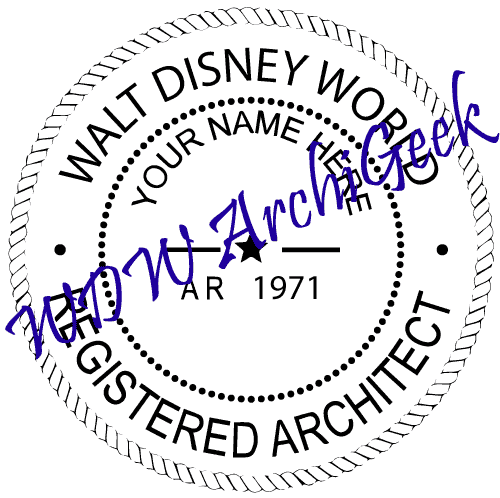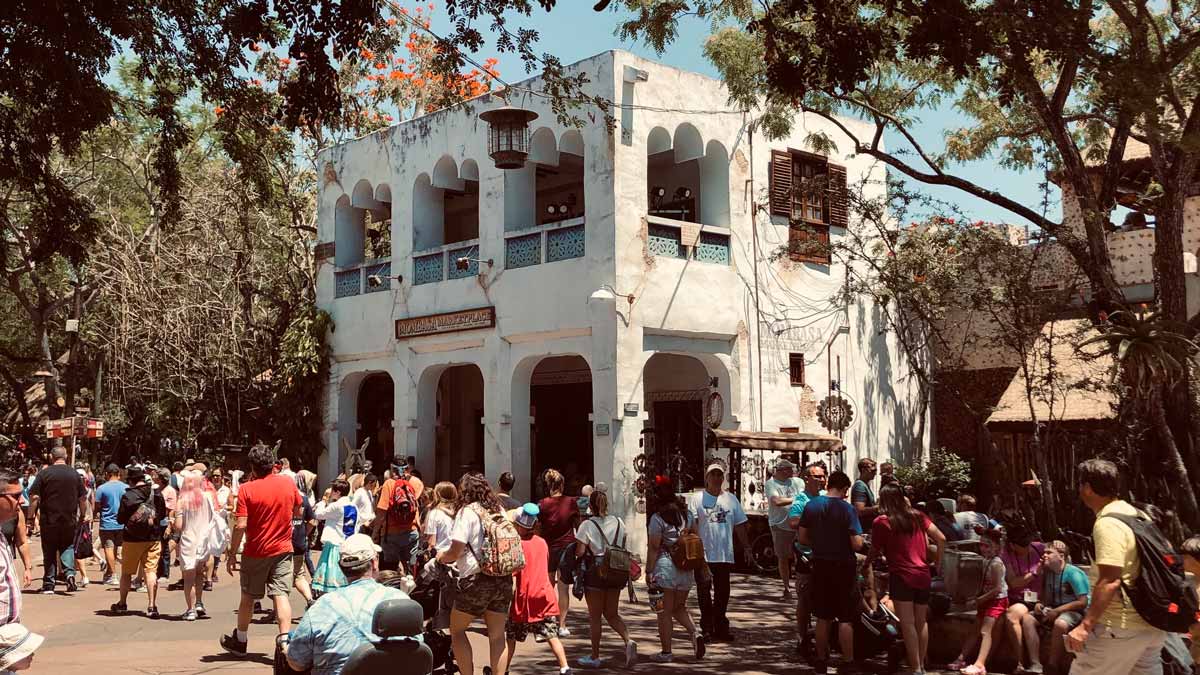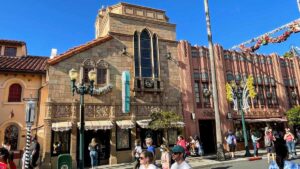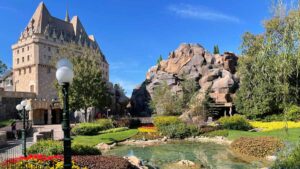We’ll make our way over to Disney’s Animal Kingdom for our next architecture post – specifically to the Land of Africa. The subject of this post is Mombasa Marketplace, one of the prominent buildings in the fictional village of Harambe. I’ll admit it – I’m no expert on Equatorial Eastern African architecture. But, here’s the thing about architecture – like most things, beauty is in the eye of the beholder. By observing a work of architecture – just like art in a museum – you are able to analyze what you see, and formulate an opinion. I mean… let’s be honest, some opinions are just wrong… but you’re still free to have them.
So, here’s my opinion.. I love it!
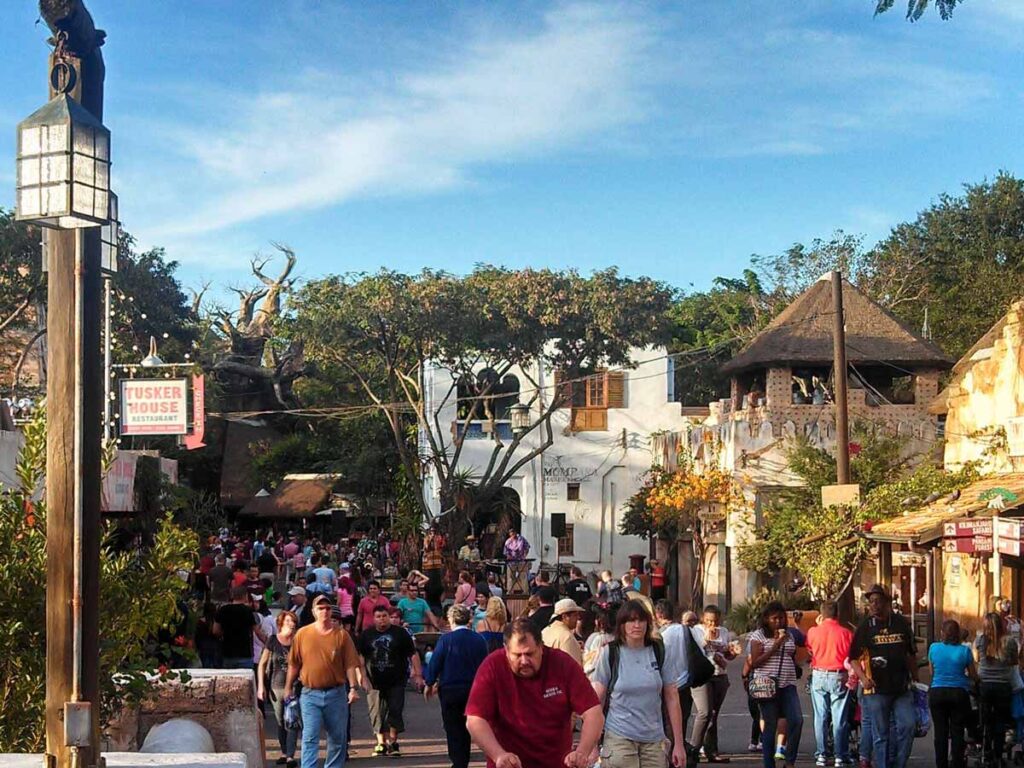
Being one of the most memorable buildings in Harambe, Animal Kingdom, it is the only building that is painted a bright white color. It announces itself, in a way, by protruding out into the street beyond the surrounding buildings. And, compared to the surrounding architecture in the town, it’s unique in that it is a symmetrical façade that faces the street.
Let’s take a closer look, shall we?
Urban Design
In order to truly understand Mombasa Marketplace’s importance, it will be helpful, I think, to examine the urban design of the village of Harambe itself.
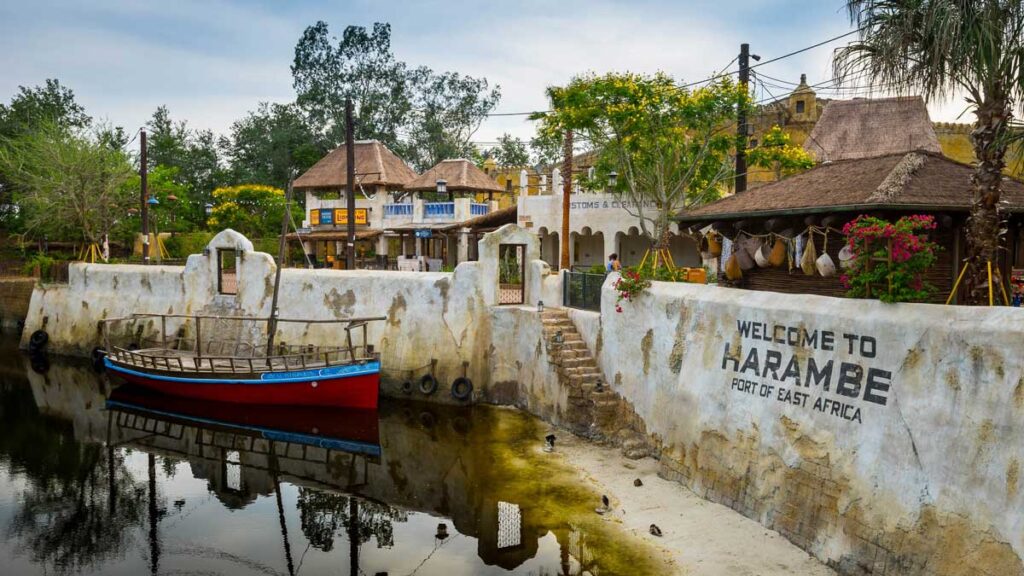
Harambe, Africa, Animal Kingdom
Harambe is derived from a typical East African coastal town from the countries of Kenya and Tanzania. So we need to start by pretending that the Chakranadi River encircling Discovery Island and fronting Animal Kingdom’s “Africa” land is the Indian Ocean. (Notice the “Port of East Africa” under the Harambe sign on the sea wall of the image above.)
According to Imagineer and Lead Designer of Animal Kingdom, Joe Rhode, this port town consists of an “Arts district”, a market street over near the train station, as well as the original Main Street, where our subject building is located. Because this Town of Harambe buts up against the jungle – where we are able to take our Kilimanjaro Safari tour – this main street doesn’t really terminate at a civic building or important monument. Instead, it sort of bleeds into a rural buffer of kiosks and huts.
Main Street?
If you’ve walked down the main street through Harambe, you might have felt like calling it a “street” is a bit of a stretch. It IS a road – a paved path – leading from the bridge between Discovery Island and Africa, to the Kilimanjaro Safaris attraction. But it also feels wide and haphazard enough to be something more akin to a public square or village center. I think that what makes the village of Harambe so charming is that these lines are indeed blurred. The village seems to have grown organically over time, as opposed to being planned out.
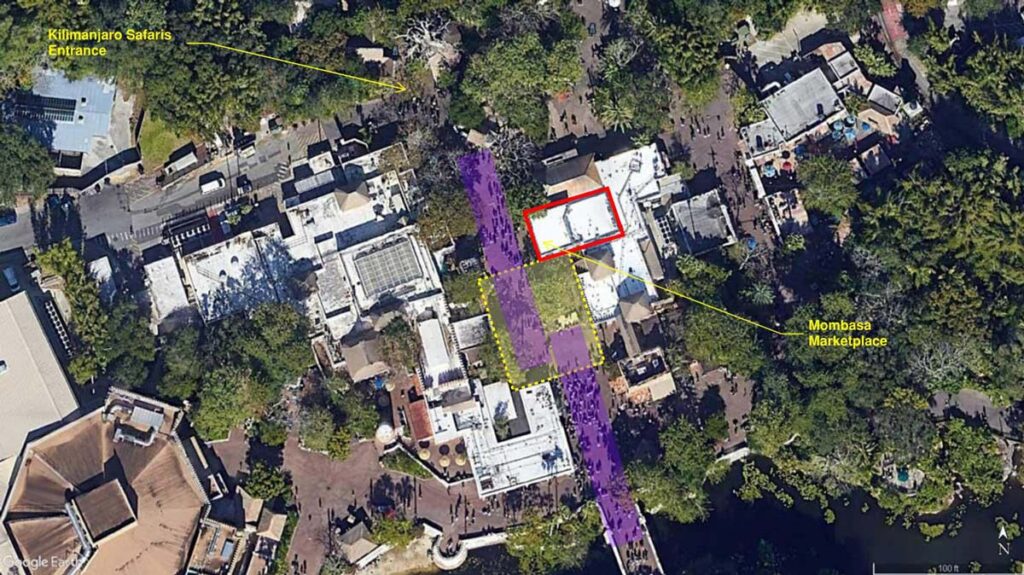
I’ve highlighted in purple what amount to straight portions of the main street through Harambe. They feel like “streets”. But, look at the dashed yellow square, where the two “streets” come together. The buildings actually frame a public space in the middle of the two legs of the “main street” that is very much a town square of sorts.
Some of the site details that Disney employs in this portion of Harambe reinforces this concept.
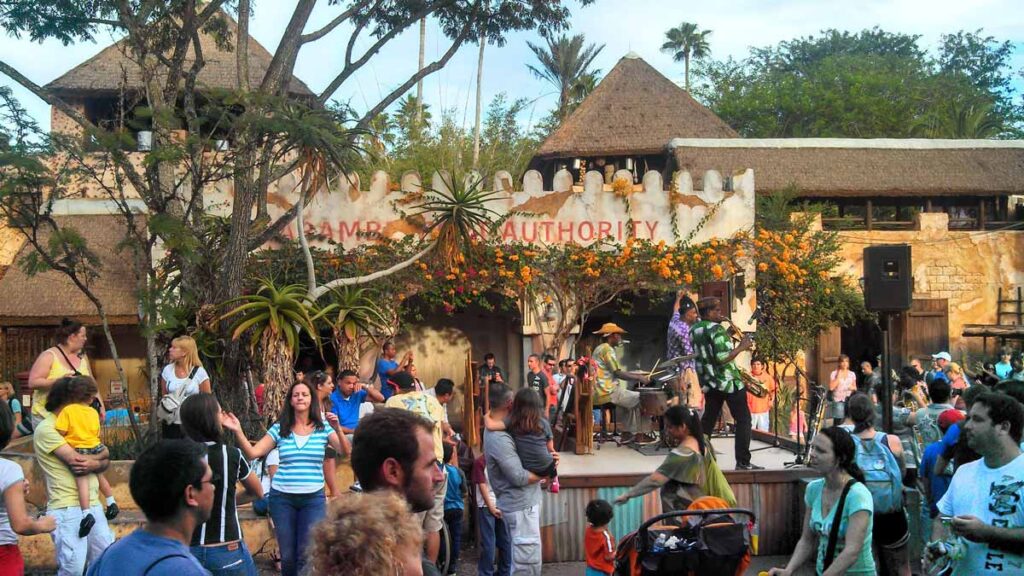
In the Northeast corner of the town square sits a large tree surrounded by a planter with built-in seats. You can just see it through the entranced people on the left of the image above. There is a semi-permanent performance stage in the square as well. Though subtle, it is pretty clear that this area of the site plan is functioning as a small village gathering place.
Um… I thought we were talking about Mombasa Marketplace?
What does this have to do with Mombasa Marketplace?

Well… snippy, aren’t we? When entering the Land of Africa at Animal Kingdom from the bridge, Mombasa Marketplace is the building that terminates your view down Main Street, announces the “jog” in the road, and prominently frames the northeast corner of the town square. It’s one of the reasons why you remember this building after you leave Animal Kingdom. It is an important building in Harambe from an urban design perspective. Not quite a “weenie“… but not anonymous either.
Architecture
Overall Form
Mombasa Marketplace’s overall form is a slightly elongated cube, although there is a large one-story space off-stage that houses part of the retail space. The street-side half of the cube is a two-story porch. And the other half implies a lower level shop and a second story apartment. You can see in the image above that the south-facing façade is essentially a square. The left half of which is an open porch.
We’ll discuss in more detail below, but the buildings in Harambe were influenced by Swahili architecture. One of the key reasons for this is that Swahili architecture consists of rectilinear forms with squarish openings and doorways, which allow for a better retail environment for guests. You can hear Imagineer Joe Rhode, talk about that here.
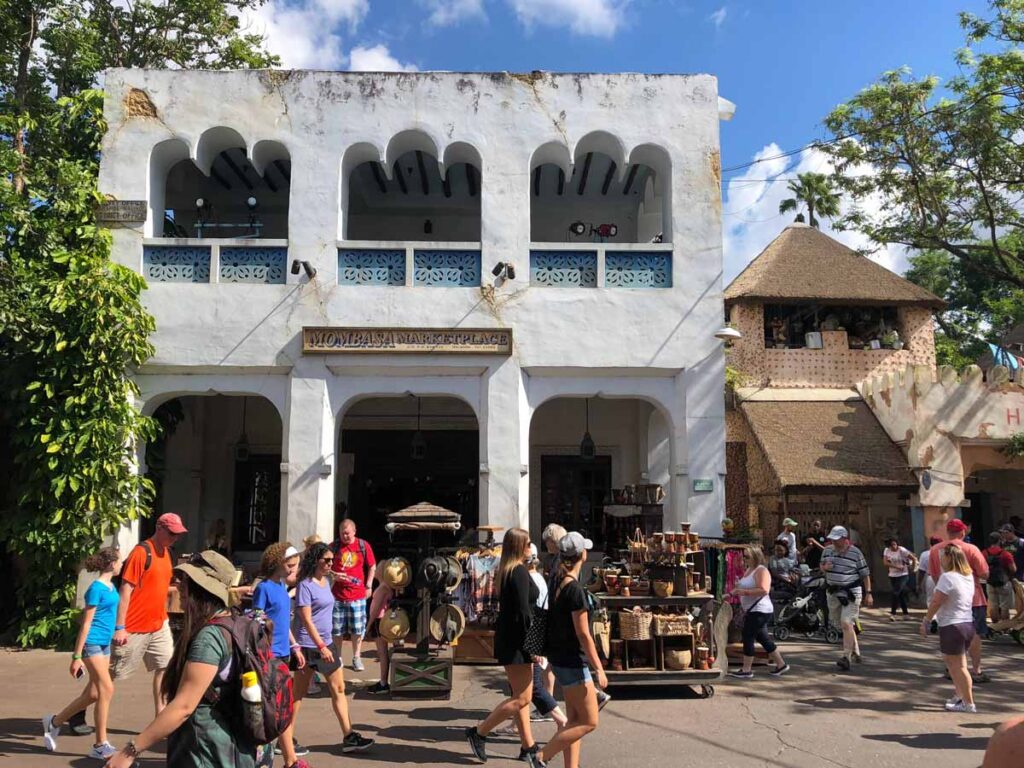
The Facade
As far as the diagram of the main façade, it’s simply a two-story symmetrical scheme. It’s a three-bay façade, meaning the building has three vertical zones on the front of the building. In this case, each bay consists of the porch and balcony openings, defined by the columns/piers in between. It’s interesting that the widths of the openings on the first and second floors are the same, but the columns on the lower level appear narrower. This is due to the beveling of the columns: they have a 45-degree angled return back to a recessed wall, where the arched openings are. You can see that better in the picture below:
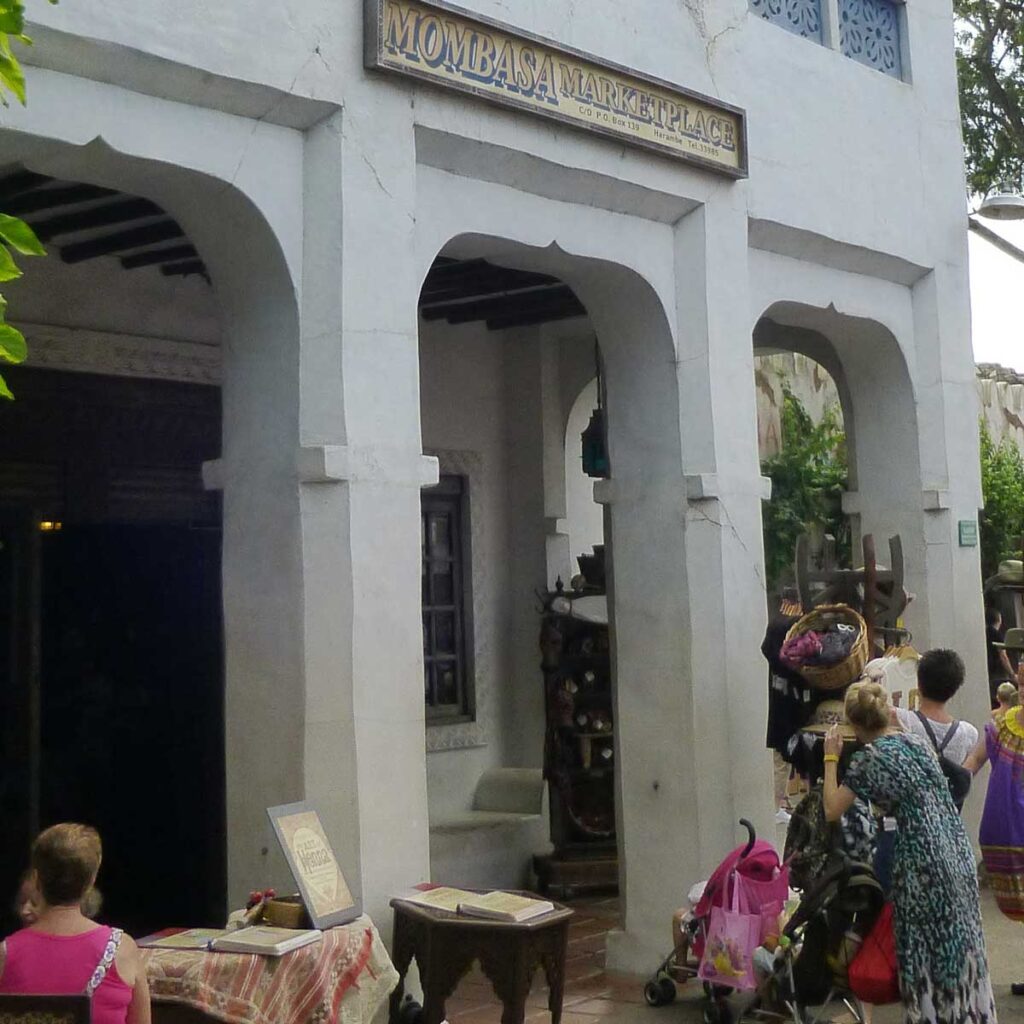
The openings are for the two-story porch on the front of the building. The lower openings in the façade are largely squarish. But quite near the top of the doorway, a flattened arch emerges with a small point at its center. Would you believe that this strange arch has a name? Seriously. It is an “ogee four-centered arch”. They don’t call this blog WDW ArchiGEEK for nothing.
The upper story arches are even more unique. They’re most akin to “round trefoil arches” but the spring-lines of the three small arches are the same. I’ve never seen it before, and can’t find an actual name for it. But it is a direct copy of this building’s primary historical precedent, which we’ll examine below. If you know the name of the arch, drop it in the comments below.
Color and Texture
As mentioned, Mombasa Marketplace is the only building in Animal Kingdom’s Africa that is bright white in color. Many of the buildings are white-ish, but many of them have a lot of weathering and staining (purposefully so). And, our building, which urbanistically seems to preside over the town square, is the brightest building in Harambe.
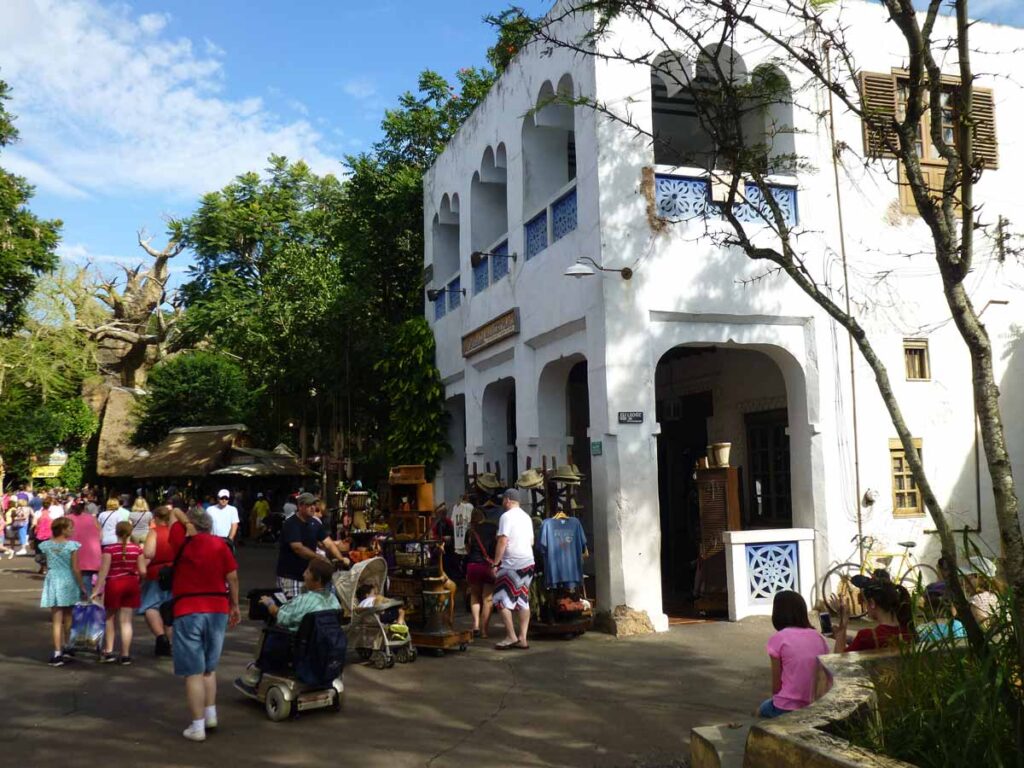
The walls of Mombasa Marketplace are finished with a smooth plaster material, which has been painted white. Blue decorative wood /plaster panels form part of the balcony railings as well as the low porch walls on the first floor. Aside from that, there are some small wood (faux-wood probably) windows and shutters on the south façade. It’s a pretty simple building in form and material.
The Imagineers tell us that the white-colored buildings in Harambe actually have a blue tint to them in Harambe, in order to emulate the buildings in Lamu, Kenya. There, in Lamu, white pigments are mixed with laundry bluing to make the white color even whiter. (Imagineers, The Imagineering Field Guide to Disney’s Animal Kingdom at Walt Disney World. Disney Enterprises, Inc., 2007.)
Details
We’ve talked about arches already. I guess I got ahead of myself because only now are we to the “Details” sub-heading. But now that we’re here, there are several other notable details that should be discussed.
Decorative panels
We mentioned the light blue decorative panels that appear within the balcony railings on the second floor, and the low walls on the side of the lower-level porch.
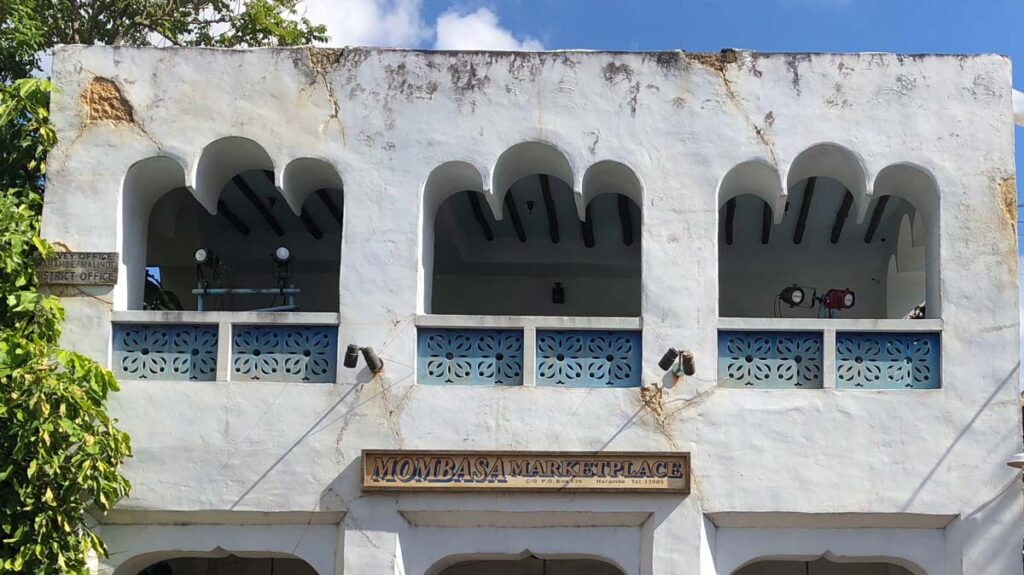
The ones at the second story are essentially wood panels with small perforations in a floral pattern. This provides some small openings in the balcony wall for some breeze and some visibility, but still maintains privacy from the hustle and bustle on the street below.
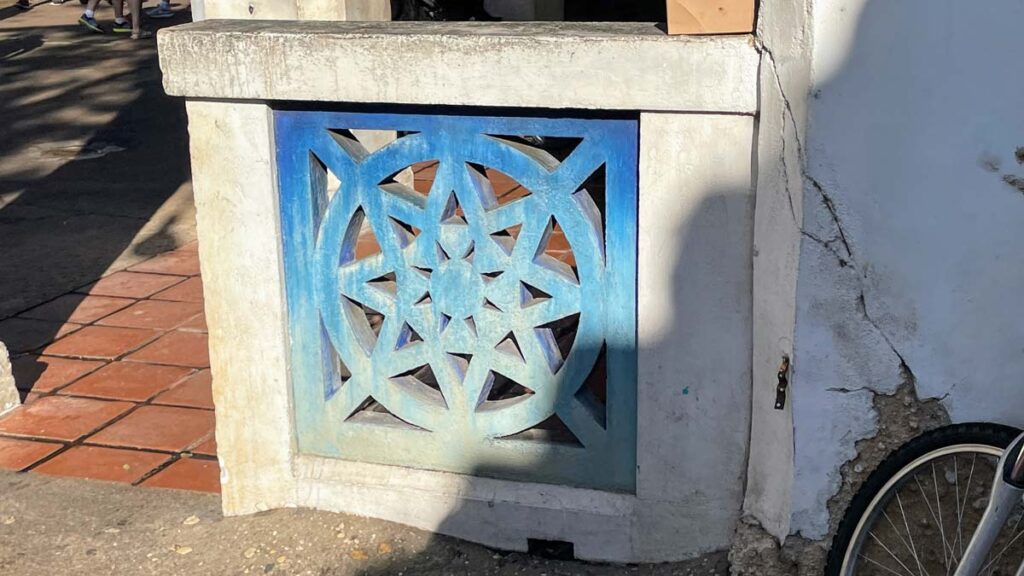
This inset wooden panel above is purely decorative. Since it doesn’t do much for the sake of privacy (it’s on the side of an open porch with merchandise being sold), it has more openings in its pattern. The geometric star with radiating elements is a common motif in Eastern African art and architecture. I love the splash of color that these decorative panels provide to the otherwise stark building.
Sign and lighting
Above the entrance to Mombasa Marketplace, a fairly humble sign announces the store.
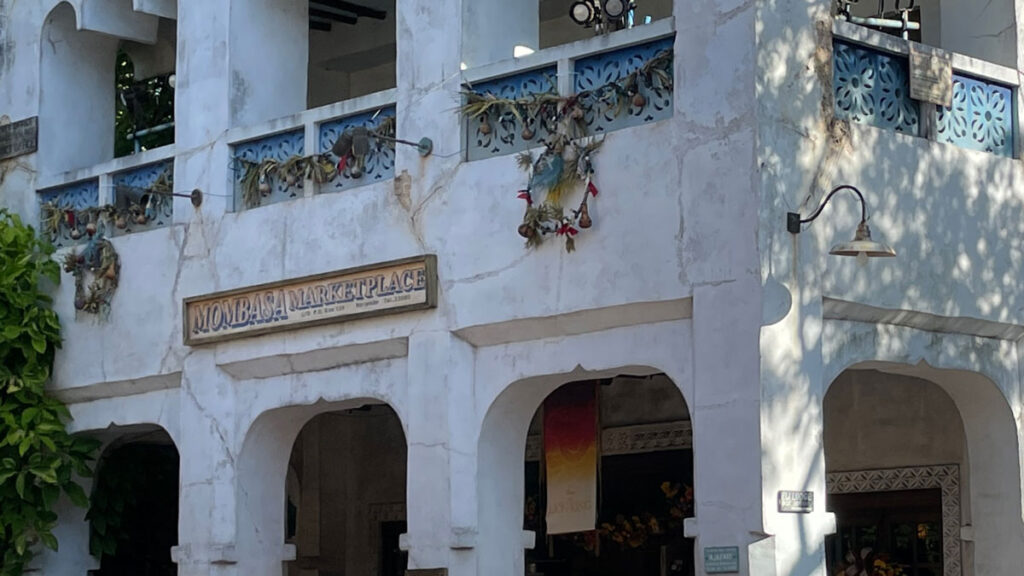
The sign is a bit too small, looks almost hand-painted and hand-framed, doesn’t provide much contrast between the letters and the field, and uses a dated font with a too-strong drop-shadow. Even this unrefined sign helps tell the story of the Town of Harambe. This proprietor can’t afford a commercially-made signing package, and can’t hire a graphic designer. So, this is good enough.
The lamps above the sign seem a bit like an after-thought, and try and do double-duty: providing some light on the ground at the entrance to the store, and very slightly illuminates the sign. That’s an efficient way to do it – buy two lights and try to get them to do what four lights could do. And note the barn-style light affixed to the façade on the right. It doesn’t match the others, but its likely what the shop owner could find, and it does the trick. Even the lack of proper lighting sets the narrative for the history and economic realities of the fictional town.
South Façade
Some of the best theming in Animal Kingdom happens through the architecture in Africa. And while its just a little piece of the puzzle, the south-facing minor façade really helps deliver the story.
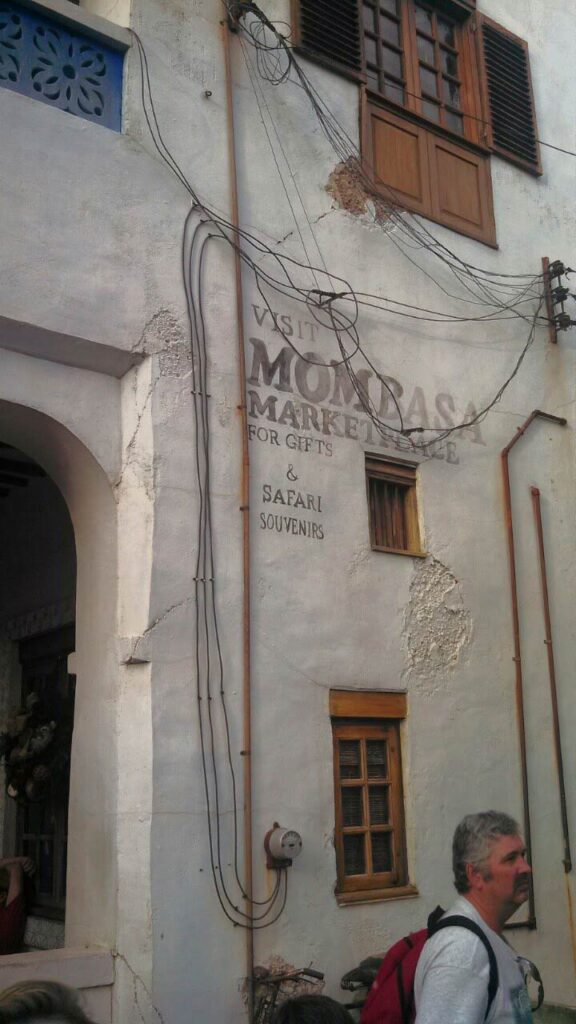
It’s even easy to miss this portion of the building, but it tells us a lot about it. The windows aren’t aligned in any way, which tells us that much of this building is simply practical and not decorative. The owners aren’t terribly interested in how the façade looks as long as the windows allow light and air into the rooms.
Because this façade is the terminus of the entry road, and frames the “town square”, the shop owner has hand-written a sign on the building wall itself so that it would be most visible to the villagers.
And maybe my favorite detail is the mass of wiring that provides electricity (and maybe phone) to the building. The Imagineers certainly designed it to look like someone at my skill level did the electrical work. Again, this detail is helping paint a picture of a third-world solution to the technology challenges of the times. It’s ad-hoc and amateurish… and it’s wonderful.
The Porch
Under the porch, we get to see some really rich detail. It’s typical of Swahili architecture for the most detailed portions of the building to be within the interiors. And at Mombasa Marketplace, the porch (which serves as a semi-private space – not really either private or public) begins to show off a bit.
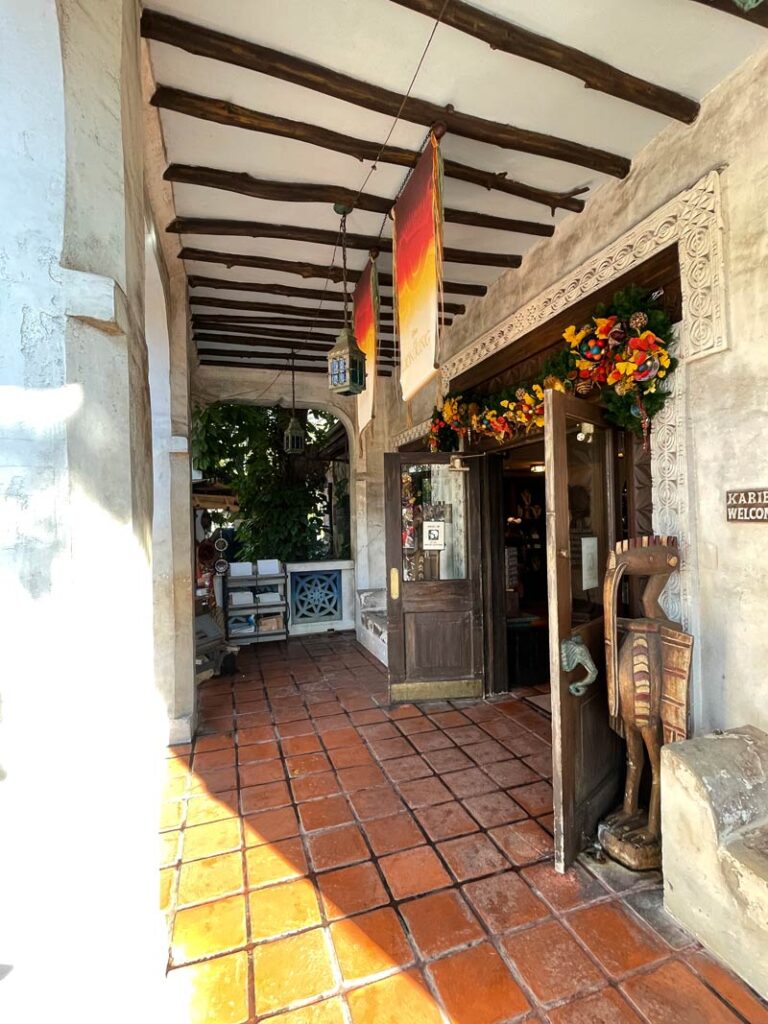
The floor of the porch is made of a ceramic tile, in stark contrast to the cracked pavement beyond in the street. The raw wood rafters that make up the ceiling structure are partially exposed against a white plaster field. The wood structural members are not refined at all, but look instead as if they were just branches hacked off of a tree and used in the building. In fact, poles made from mangrove trees are often used as the structure in Swahili homes. All of these details develop the theme.
Two other notable details here. One – there are built-in stone benches on either side of the doors. This is sensible because this close to the equator (Africa, not Florida), sitting under a shaded porch with access to the ocean breeze is far more desirable than sitting inside your unconditioned house. Secondly, note the beautifully carved plaster door surround. The door, and its trim, are the most ornate elements in the entire building. It’s providing a glimpse of the level of care and detail that is within the typical Swahili home.
Historical Precedent
Now’s a good time to talk about the inspiration for Mombasa Marketplace. Swahili architecture is the precedent for the architecture of Africa in Animal Kingdom. The style is found throughout the cities on the eastern coast of Africa, especially in Kenya and Tanzania. Imagineers have said that the Village of Harambe is, specifically, a smash-up of the cities of Lamu, Kenya and Arusha, Tanzania. Those are the source materials for Disney’s Africa.
Swahili architecture
Swahili architecture might not be familiar to you, but it is arguably the most rich architectural tradition in Africa. Archdaily.com says that is “an architectural representation of a cultural combination of influences ranging from mainland Africa to the Arabian Peninsula and South Asia.” Translation: Swahili architecture is an amalgamation of several different other styles from nearby cultures – especially those on trade routes on the Indian Ocean.
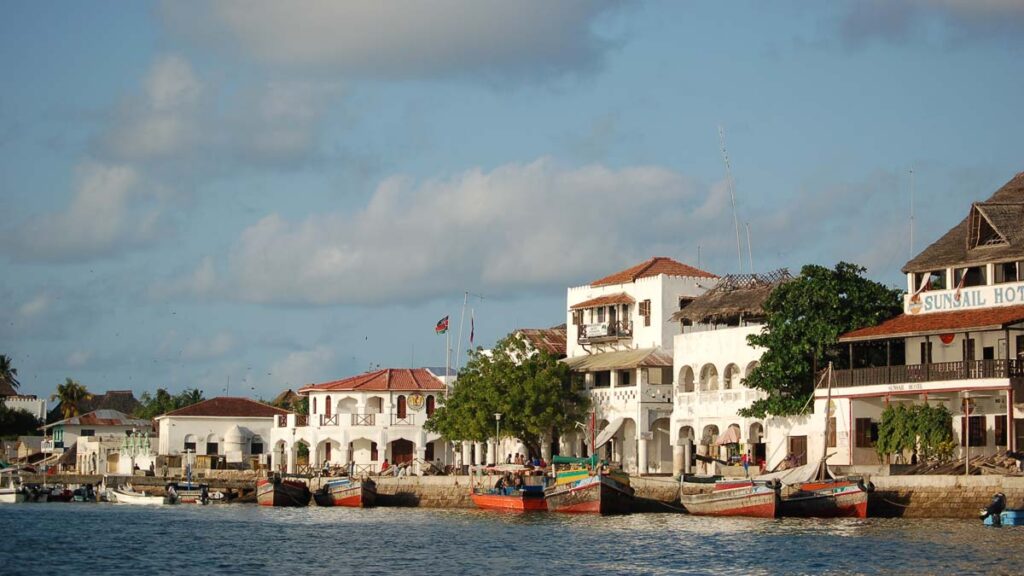
The gleaming white coral limestone walls – like we see in Mombasa Marketplace – are a defining characteristic of the style.
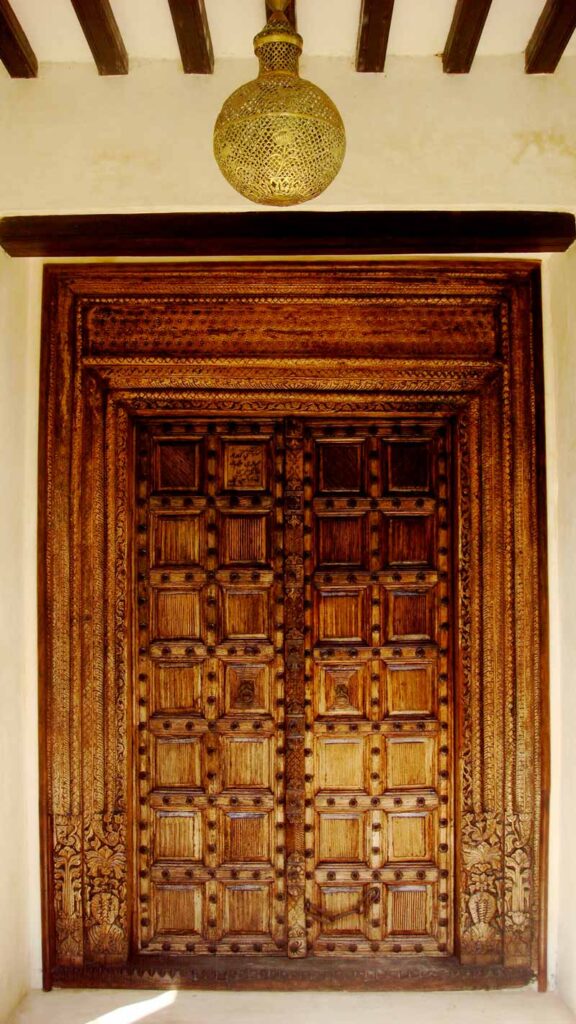
And so are the highly ornate doorway surrounds. In these doorways, it’s easy to see the influences from the Middle East and India. The carvings in the lintel above the door often contains Arabic inscriptions from the Quran or the homeowner. Think of them as similar to the names on the porches of beach homes (“Sea Geek”, “Surf-itect”, “Beachy Keen”). These doors sit often within a porch (called a daka).
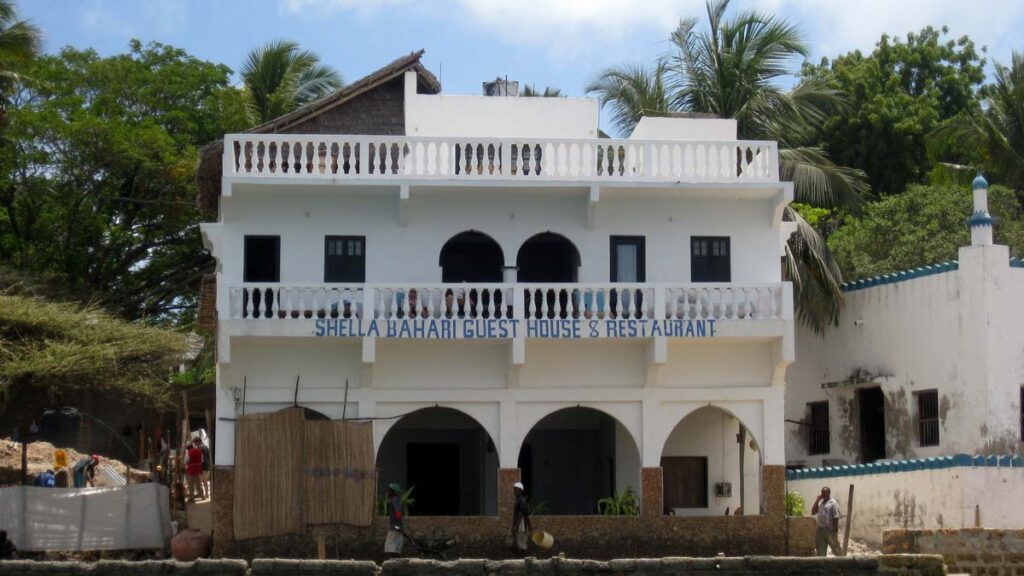
Traditional Swahili homes are characterized by thick external walls and small windows in order to protect the family from the equatorial sun, and to provide privacy. Many of the coral and lime block walls are covered with a water-resistant layer of a white lime and cement mixture. The floor and roof structures are made from tropical wood, like mangrove, and consist of beams spaced closely together. These are often exposed in the ceilings, which bring a beautiful warmth into the interiors of the buildings. You can see some of these in the image of the door earlier.
Town Square of Lamu
Mombasa Marketplace has a specific precedent it would seem. It is strongly inspired by a building in the Town Square in the City of Lamu. Although the Square’s main anchor is the old Fort of Lamu, there is a building in the square whose architecture looks a LOT like the one in Disney’s Africa in Animal Kingdom.
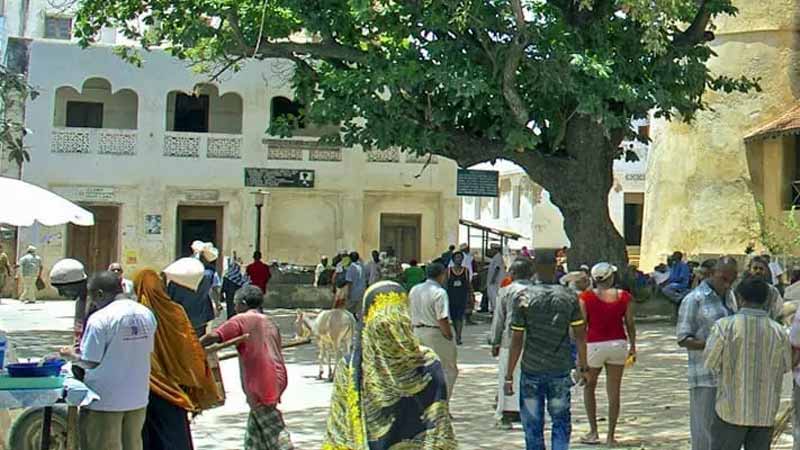
It’s a four-bay façade – as opposed to three in Mombasa Marketplace. And it is a three-story building – as opposed to the two-story one in Harambe. But it has smooth white exterior walls and a two-story porch. And check out the similarities in the upper story of the balcony… Those unique trefoil arches are there… as are the decorative panels in the railings (painted white, not blue).
And, to add to the familiar scene, the massive tamarind tree sitting in the town square, ringed by a stone planter with seating, looks remarkably similar to the condition in our Town of Harambe. Look below:
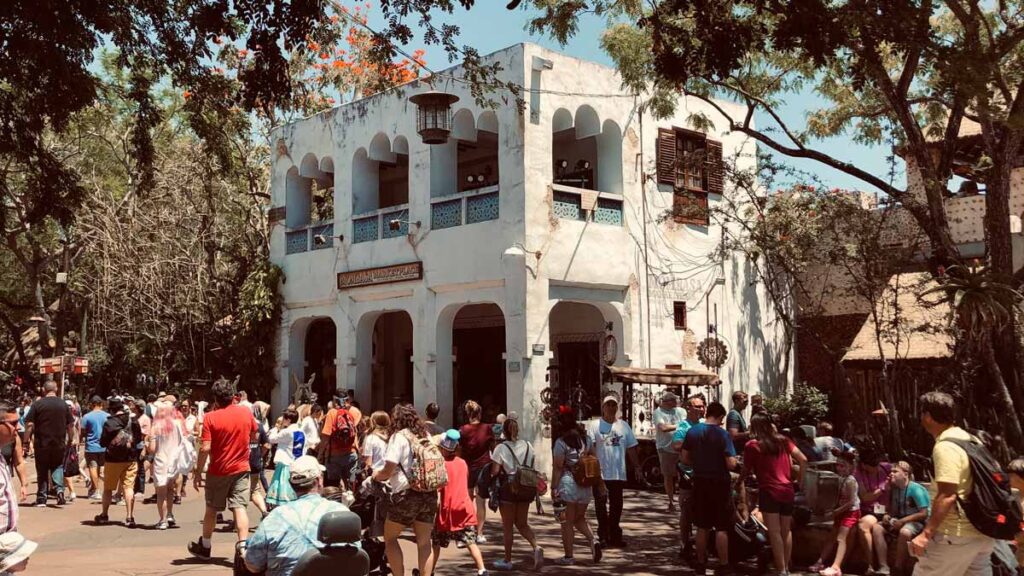
The similarities are pretty striking.
Interior
I don’t typically focus on the interiors of the buildings at Disney World. But at Mombasa Marketplace, the theming and Swahili influence continues into the shop itself.
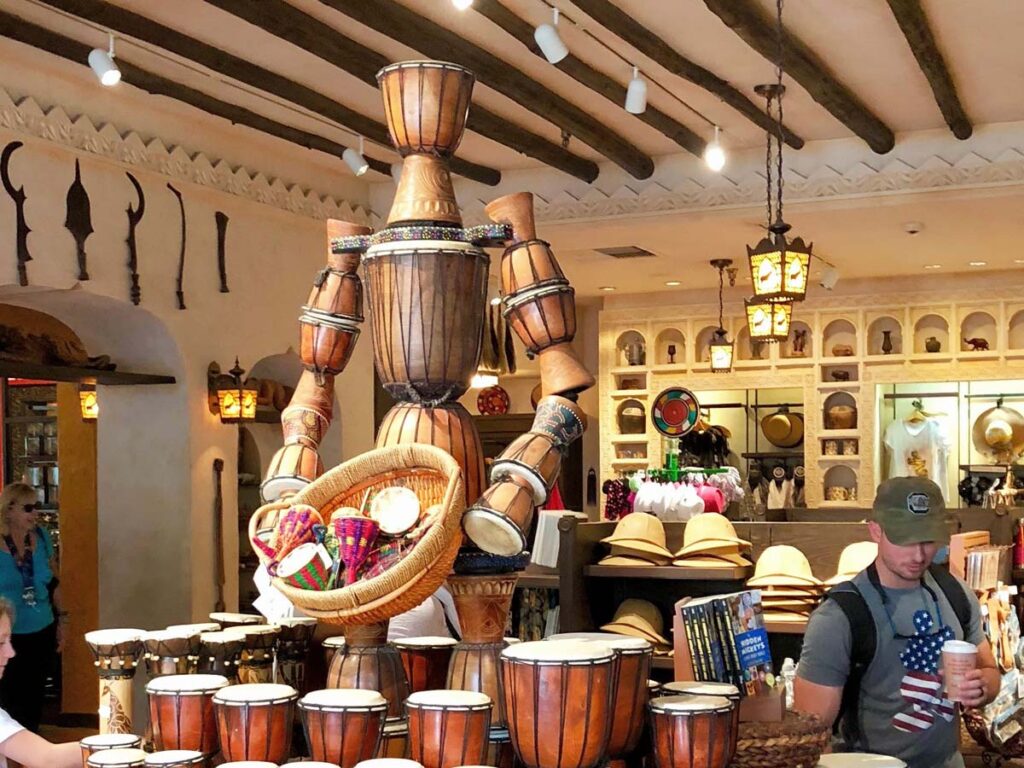
Notice the mangrove beams in the ceiling in the photo above. And “Hello” to Djembe Guy – very clever, Disney. Check out the back wall of the store. Do you see the decorative niches displaying artifacts and trinkets?
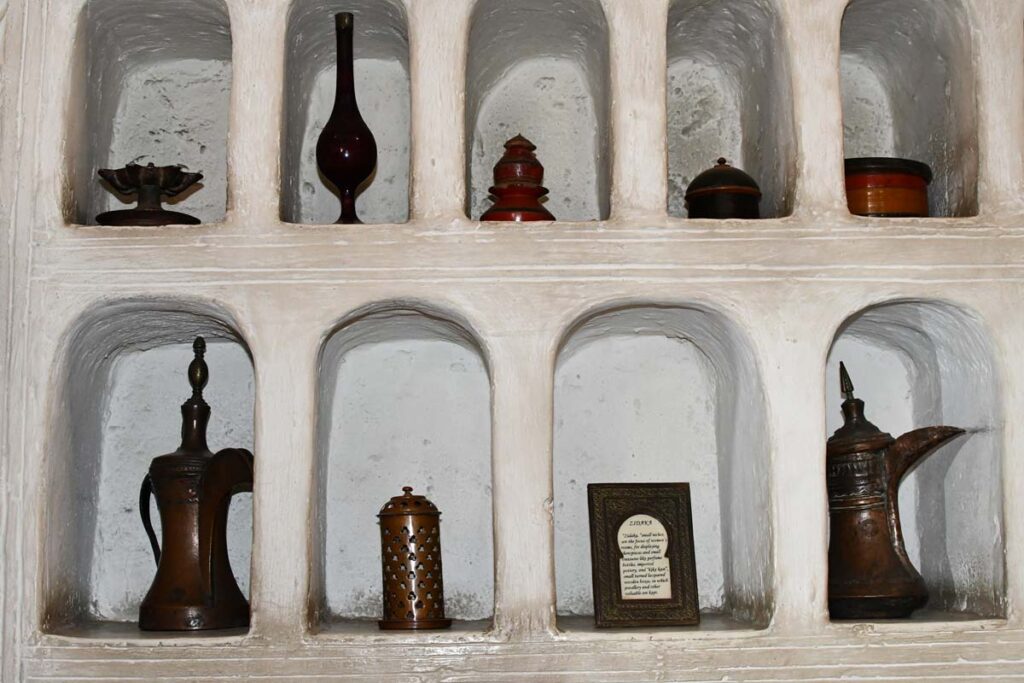
Those are called zidaka, and they are common in traditional Swahili homes. Some of the examples look remarkably like the one in Mombasa Marketplace. (Unfortunately, most of the photos I’d use are copyrighted. Click here for some examples on the google.) Often the surrounding plasterwork of these zidaka are highly decorative, and they house religious texts and foreign artifacts from across the Indian Ocean.
Conclusion
When I think of the Land of Africa at Animal Kingdom, Mombasa Marketplace is the building that comes to mind. It’s iconic – in part because of its location defining the edge of the village square, and in part because of its authentic gleaming white Swahili Architecture. It’s a wonderful piece of architecture. Well done Imagineers! I’ll stamp this one.
